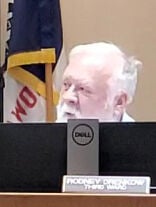The state of Iowa was repeatedly telling the city of Waverly what to do, city officials noted at the July 7 Waverly City Council meeting. In one case, the council said no.
At least three action items were born of new state laws, most of which took effect July 1.
According to one new law, the state now requires city zoning ordinances to allow accessory dwelling units, which could look like a detached grandparents’ flat or carriage house. Before the council passed the third reading for adoption, it required a public hearing.
The council also passed another resolution on the aquatic center reducing construction retainage from 5% to only keep back 3% in case of . When the project is complete or terms are met, the retainage is to be released to the contractor.
‚ÄúIt‚Äôs another law that took effect July 1. The state legislature changed (it so) we can only charge (withhold) 3% (of payment as retainage), instead of 5%,‚ÄĚ City Administrator James Bronner said.
Later, the City Council declined an action item to repeal the part of City Code that formed the Human Equity and Diversity (HED) Commission, Chapter 32.
A motion to repeal Chapter 32 died for lack of a second, so it will stay in City Code for now.
At the Sunset Pride Float last month, HED Commissioner Jenn Wolff said that June marked the commission’s last meeting in a city capacity, which city staff confirmed.
The ramifications of not repealing Chapter 32 were not immediately known by city staff.
Council members Wolff and Ann Rathe were absent Monday.
The state law banning most diversity, equity and inclusion (DEI) efforts in public entities, Iowa , was signed into law on May 27. From a reading, it tells local governments not to engage in promoting concepts it finds related to DEI, for example, ‚Äútransgender ideology‚ÄĚ but also ‚Äúallyship,‚ÄĚ ‚Äúintersectionality,‚ÄĚ or even ‚Äúheteronormativity‚ÄĚ ‚Äď which Webster defines as the attitude that heterosexuality is the only natural expression of sexuality (Iowa Code 19.1, 1.E).
In closing comments, council member Brent Jones said he was going to use Mayor Mark Anderson‚Äôs closing words from recent months, ‚ÄúWaverly, be kind.‚ÄĚ He did not specify which agenda item he was referring to. Anderson echoed the message.
Accessory dwellings
No one from the public spoke at a hearing about accessory dwelling units (ADUs) on July 7, but the council had a lively discussion.
After closing the hearing, three city elected officials said they opposed state mandates ‚Äď council members Rod Drenkow, Julie Meyers and Mayor Anderson. Those saying they were not opposed to ADUs were Meyers and two nonvoters, guest council member Jacob Farran and Anderson.
An accessory dwelling, Anderson explained, is a small house the lesser of up to 1,000 square feet or 50% of the size of the single-family dwelling located on the same lot. Anderson wasn’t totally opposed to allowing ADUs but wanted more time to think it through.
Reading the ordinance, an accessory dwelling can accompany a single family home in a residential two-family zone (R2). An ADU can also be in a multi-family (R3) or multifamily transitional (R4) district.
Looking at the Waverly zoning map, most of the heart of town is zoned for up to two-families (R2), with exceptions.
The single-family zones (R1) mostly run on the outskirts. The Waverly zoning map can be viewed at the shortened link, . The map can be enlarged to read street names.
Council member Rod Drenkow said the city has to permit ADUs that fit within its zoning ordinance and expressed frustration at the lack of control.
‚Äú(It‚Äôs) out of our hands, which I despise, frankly, the way the state legislature is making these decisions for us,‚ÄĚ Drenkow said.
Anderson said, ‚ÄúAt first glance, this looks like a good idea; this is where Grandma could live by the grandkids. There‚Äôs nothing in the ordinance that I see that says this couldn‚Äôt be student rentals. Could this be a camper up on cinder blocks? (‚Ķ) I wish the legislature had given us more time to think this through and ask citizens more of what they want.‚ÄĚ
Jones asked if the county could assess taxes on accessory dwellings.
Administrator James Bronner said the law took effect July 1 and the city is trying to catch up with what it means.
‚ÄúIt‚Äôs not a separate parcel; is it a separate building on the same parcel?‚ÄĚ Bronner mused.
Council Member Julie Meyers said she and her husband had, a few years ago, studied the possibility of letting their kids purchase their property and building an accessory dwelling in the backyard.
‚ÄúIt didn‚Äôt fit in the building code at that time, and we moved on,‚ÄĚ Meyers said.
‚ÄúThe concept of the ADU is a growing trend and it‚Äôs worth looking at, but I wholeheartedly disagree with the state mandating this,‚ÄĚ Meyers said.
The guest council member for July, Jacob Farran, who introduced himself as a fourth-generation Waverly resident, spoke in favor of accessory dwellings as providing ‚Äúa lot of opportunity for Waverly.‚ÄĚ Farran echoed council discussion points of multi-generational living; the opportunity to build rentals, such as for college students; and said, ‚Äú(An ADU) increases property values.‚ÄĚ
‚ÄúIt increases ‚Äėgentle density,‚Äô‚ÄĚ Farran added. ‚ÄúThis is a way for Waverly to grow without changing the look and feel of the neighborhoods. (‚Ķ) It is a recent trend, but it is also a very historic thing.‚ÄĚ
Farran gave the example that Savannah, Georgia, makes use of accessory dwellings and has done so historically.
‚ÄúI think these are great opportunities to look at how those cities have done it and incorporate that because I do see a lot of opportunity in these ADUs for Waverly,‚ÄĚ Farran said.
The council moved to the third and final reading of the ordinance amending Waverly Municipal Code to add ADUs, in Ordinance 1170, which passed.














